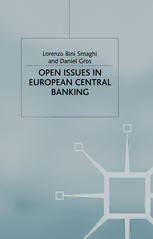
Open Issues in European Central Banking PDF
Preview Open Issues in European Central Banking
Open Issuesin European Central Banking Open Issues in European Central Banking Lorenzo Bini Smaghi Director{orInternationalAffairs ItalianTreasury Rome and Daniel Gras DeputyDirector Centre{orEuropeanPolicyStudies Brussels palgrave macmillan © Lorenzo Bini Smaghi and Daniel Gros 2000 Softcover reprint of the hardcover 1st edition 2000 978-1-349-41813-8 All rights reserved.No reproduction,copy or transmission of this publication may be made without written permission. No paragraph of this publication may be reproduced,copied or transmitted save with written permission or in accordance with the provisions of the Copyright,Designs and Patents Act 1988, or under the terms of any licence permitting limited copying issued by the Copyright Licensing Agency,90 Tottenham Court Road,London W1T 4LP. Any person who does any unauthorised act in relation to this publication may be liable to criminal prosecution and civil claims for damages. The authors have asserted their rights to be identified as the authors of this work in accordance with the Copyright,Designs and Patents Act 1988. Published by PALGRAVE Houndmills,Basingstoke,Hampshire RG21 6XS and 175 Fifth Avenue,New York,N.Y.10010 Companies and representatives throughout the world PALGRAVEis the new global academic imprint of St.Martin’s Press LLC Scholarly and Reference Division and Palgrave Publishers Ltd (formerly Macmillan Press Ltd). ISBN 978-1-349-41813-8 ISBN 978-0-333-98188-7 (eBook) DOI 10.1057/9780333981887 This book is printed on paper suitable for recycling and made from fully managed and sustained forest sources. Logging, pulping and manufacturing processes are expected to conform to the environmental regulations of the country of origin. A catalogue record for this book is available from the British Library. Library of Congress Catalog Card Number:99–40985 CONTENTS Foreword ix Introduction 1.Who isin chargeofthe Eurosystem? 5 Introduction 5 1.1.The decision-making process 6 Whatthetreatystates(andwhatitdoesn'tstate) 6 Thebalance ofpower 9 TherisksofaweakECB 11 1.2.Implementation 17 Theinterpretation ofthetreaty 17 Theunderlying reasonsfordecentralization 20 Theconsequences ofdecentralization 23 1.3.Is(de)centralizationsustainable? 25 2.Who takes careoffinancial stabilityin Europe? 29 Introduction 29 2.1.Preventing fmancialcrises 30 Theinstruments 30 Financial regulation intheED 31 Prudential supervision 35 2.2.Financial crisismanagement 40 Solvency andliquiditycrises 40 Bailingoutbanksinmonetaryunion 41 Thelender-of-last-resortinmonetary union 45 Who(intheEurosystem) shouldlendinthelastresort? 49 2.3.ShouldtheEurosystembegranted supervisorypowers? 51 Conclusions 55 Annex 2.1.Doesprudential supervision interfere withmonetarypolicy? 58 v VI Contents 3.AreEuropean centralbanks over-capitalized? 67 Introduction 67 3.1.The Eurosystemand itscomponents 68 3.2.AcomparativeG-3perspective 70 Liabilitiesandsize:Acomparisonwith theUS andJapan 70 The compositionoftheasset side:Foreignexchangeassets 73 Balancesheet size:Does itmatter? 76 3.3. CleaninguptheEurosystembalancesheet 80 Aleanbalancesheet 80 Excess foreign exchangereserves? 82 Conclusions 84 Annex3.1.An exampleofsimplicity: The allocationofassets andreturns intheFederalReserve System 86 Annex3.2.Estimatingtherevaluationreserves using aVaR approach 88 4.Who gets theseigniorage? 94 Introduction 94 4.1. What isseigniorage? 95 4.2. The treaty'sprovisions 96 4.3. Theproblems 98 4.4. The agreednon-solution 103 4.5. Alternativeapproachestophasing-in 105 Conclusions 108 Annex4.1. Legal Issues 111 Annex4.2. The distributionofseigniorageinthecontext ofthefiscal constitutionoftheEU 112 Contents VII 5.How can theEurosystembecome(and remain) independent? .. 118 Introduction 118 5.1.Theindependenceprovided bythetreaty 120 Statutoryindependence 120 Functional independence 122 Economic independence 123 Personalindependence 124 5.2.Measuring theECB'sindependence againstthatof othercentralbanks 125 5.3.Thelimitsofmeasurement 129 5.4.PotentialthreatstotheECB'sindependence 132 Theexchangerateregime 132 NCBs' activities 'outside'the ESCB 136 Conclusions 138 6....and accountable? 144 Introduction 144 6.1.Democratic control,independence andaccountability 144 6.2.Theeconomics ofcentralbankaccountability 147 6.3.Howtoassesscentralbankaccountability? 151 6.4.Howaccountable istheECB? 157 Conclusions 166 7.3X2ConcreteProposalsfor Strengthening theEurosystem 171 Introduction 171 7.1.Transform theEurosystem intoatrueEuropean CentralBank 171 7.2.Clarifywhoisresponsible forfmancial stability 172 7.3.Clarifyfmancialrelationships withintheEurosystem 174 Contents Vlll Annexes I. Chapters 2and3ofTitleVIonEconomicand MonetaryPolicyoftheTreatyonEuropeanUnion 177 II.Protocol (No.3)onthe StatuteoftheEuropean Systemof CentralBanksandoftheEuropeanCentralBank 186 Index 205 NamesIndex 208 List ofTables and Figures Tables 1.1 StafflevelsattheNCBsandtheEeB, 1998 10 1.2 Eurozone policy indicators 15 1.3 TheEurosystem'smonetary policyoperations 18 1.4 Operational stepsinthetender procedure 19 2.1 EUbankassets, 1996(percentage oftotalassets) 34 2.A.I'· Resultsofregressions 61 3.1 Centralbankbalance sheets(liabilityside) 71 3.2 Index ofcentralbankcapitalization 72 3.3 TheEurosystem'sbalance sheet 81 4.1 Basicdataforseigniorage distribution inEMU 100 5.1 Ranking ofcentralbank independence 127 6.1 Accountabilitycriteria 153 Figures 3.1 Ratiosofforeign assetsandgoldovermonetary base 74 3.2 Average inflation andcapitalization indicator 77 3.3 Indicator ofcentralbank independence andleancapitalization 78 4.1 Theratioofcurrency incirculationtoGDP 102 4.A.l Thedifference between GNPratiosandtheECBcapitalkey 114 FOREWORD We have both been directly involved for many years in European monetary integration and have benefited, inour frequent exchanges of views, from our complementary positions, as official and independent academic, respectively. This book puts forward a common reflection onsome key issues inEuropean central banking that we think, from our privileged viewpoint, represent important challenges forthe near future ofEurope. The opinions expressed inthis book reflect only those ofthe authors. The experience gained in our respective institutions have nevertheless been essential in providing us with a deeper understanding of all the aspects related to the economic and monetary unification of Europe. We are thus grateful to all our colleagueswith whom we have worked inthe course ofthe lastfew years. Special thanks are owed to Pierre Jaillet and Ulrich Ramm who took the time to comment on the manuscript. Daniel Gros' contribution to this volume would not have been possible without his many conversations with colleagues at CEPS and from its large European network. We also wish to express our gratitude to Franziska Schobert, who co-authored Chapter 3 and contributed to Chapter 4, to Luigi Cucca and Anne Harrington who edited the text with great speed and to Karin Godyns, who followed the project faithfully through its differentstages. Brusselsand Rome June 1999 ix
